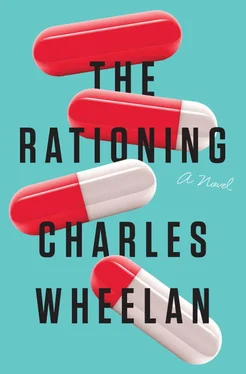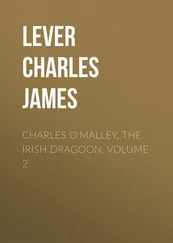“Give her a little breathing room, please,” I told them. Giscard repeated my admonition in French (though I am certain they understood my instructions in English perfectly well).
“It’s fine,” the NIH Director said. And then, more directly to the film crew, “You’ll want to get this.” Everyone who heard that curious remark stopped working and turned to the Director. She continued, “Could I have everyone’s attention, please?”
The clicking of keyboards slowed and then stopped. The two camera operators sidled even closer. “I just received a call from the President’s Chief of Staff,” the Director said, projecting her voice across the room. “She informed me that the Indian Prime Minister has offered the United States five hundred thousand doses of Dormigen. That medicine will be on a plane bound for Washington shortly.” A loud cheer erupted in the room, but there were also a few sighs of disappointment. We were all relieved, obviously, but we were disappointed, too. We could have figured this thing out , I was thinking, as were many others. Perhaps sensing this emotion, the Director continued, “The Chief of Staff asked me to tell the people in this room one other thing.” She paused to put on her reading glasses and unfold an ordinary piece of copy paper on which she had scrawled several sentences. “This is an exact quote: ‘Our leverage in the negotiations came from the blistering pace of progress we were making on the virus. Without that, there would be no Dormigen on its way to the United States right now.’ The Chief of Staff asked me, on behalf of the President, to thank each and every one of you.” There were hearty cheers. The French film crew turned their cameras on the room to capture the reaction.
After the Director left, our room was oddly still for several minutes. A few people, exhausted from the all-nighter, left to get real food or to go home for some sleep. But most of us did not want to leave. There was a unique bond in the room, holding us there together. The crisis may have passed, but the urge to figure out Capellaviridae had not. Less than fifteen minutes after the Director addressed the room, a group of biologists, a joint Northwestern–University of Chicago team, posted the most extraordinary finding yet: when the North American dust mite transmits Capellaviridae to humans, it also passes along an enzyme that destroys the older Capellaviridae viruses already in the body. “New Capellaviridae viruses get swapped out for the old ones, effectively,” they wrote in the What does this mean in plain English? section of our Google Doc. We recognized immediately that this could easily be the piece of the puzzle we had been waiting for.
“Do they know?” Giscard asked no one in particular, his distinctive voice rising above the clatter in the room.
“What?” I asked.
“Do they know we have the Dormigen?”
“I’m not sure it matters,” I replied. That reading of the situation turned out to be broadly correct. Our site had more meaningful posts over the next twenty-four hours than we had in the first twenty-four.
THE INDIAN DORMIGEN PLEDGE SET IN MOTION A FLURRY OF logistical activity. The NIH was worried about Dormigen shortages in rural areas, even with the arrival of the Indian doses. It would be roughly thirty-six hours before the new Dormigen arrived on the East Coast, and then at least another twenty-four hours before it could be distributed to all parts of the country. Deep in the bowels of Homeland Security, some nameless bureaucrat opened up the electronic equivalent of a binder: Pandemic Drug Distribution. There were other such “binders”: bioterror evacuation, and nuclear accidents, and dirty bombs. The people who prepared these binders went home at night hoping that nothing they ever did would be relevant.
But on this day, the “binder” came off the shelf. Once the Indian Prime Minister’s plane touched down in D.C., the U.S. Air Force would take the lead in moving the Dormigen to the major metropolitan areas. From there, National Guard units would ferry it to more remote areas with the assistance of private couriers, as necessary. There had been simulations of this exercise before; now the contingency plan was set in motion for real. The Air Force began flying a massive fleet of cargo planes to airports in and around Washington, D.C. National Guard units in all fifty states were called up for duty. National Guard trucks and planes, with their respective drivers and pilots, were assembling near airports in the major cities. The maps and routes had already been drawn up. It was all in the binder.
The planning on the India side was more ad hoc. The Prime Minister requisitioned an Air India 747 cargo plane to make his historic flight and requested that the aging plane be repainted for the occasion. When he was told that a 747 could not be painted in twenty-four hours, he settled for having enormous Indian and American flags painted on the tail and fuselage. The hulking 747, a beautiful plane under normal circumstances, looked appropriately majestic for the PM’s mission. The U.S. Embassy was testing samples of the Dormigen as it was loaded on the plane. This request had come from the CDC in Washington, where there was some fear that a high proportion of the Indian Dormigen might be counterfeit or expired.
Nearly all attention in India was now focused on the Prime Minister’s “toilets and televisions” initiative. “I assume you’re joking,” the Secretary of State had said when an aide hustled into her temporary office at the embassy and described the program.
“Nope. Fifteen thousand villages in forty-eight hours,” the aide said. “That’s the plan.”
Less than an hour earlier, the Indian Prime Minister had announced a plan to furnish fifteen thousand villages with a sanitary latrine, a television with a satellite dish, and a solar panel that would generate sufficient electricity to power the television. The Prime Minister proclaimed, “In the middle of the twenty-first century, no Indian village should be without a clean, sanitary toilet. And no village should be cut off from the rest of the country.” He bypassed the legendary Indian bureaucracy and enlisted the Army to carry out his edict. A public school teacher in each of the designated villages was recalled to the nearest population center, where he or she was paired with a small contingent of soldiers who would return to the village—often hiking for hours to remote places with no road access—to dig the latrine and install the solar panel and television.
The Prime Minister called the program “Technology for India” or something like that; within a few hours, even he was referring to it as “toilets and televisions.” His political opponents went ballistic, declaring the obvious: the PM wanted to ensure that even the smallest village (where voter turnout tended to be quite high) would be able to witness his heroic journey to the U.S. At first the Prime Minister’s lackeys tried to argue that the program’s timing was coincidental. Eventually that charade became impossible to maintain, since every village participating in the program was given a single sheet of paper with a description of three things in the simplest possible language: (1) instructions for the television; (2) an explanation of how and why using the latrine could prevent the spread of disease; and (3) a description of the PM’s flight to America, including a photo of him posing in front of the 747 and its enormous Indian and American flags.
The new toilets turned out to be perfect insulation against charges of political opportunism; public health officials reckoned they would save thousands of lives in the long run. The solar panels, too, would be beneficial, as they could be used for other village functions, such as charging mobile phones and powering lights so students could study at night. In the end, the PM’s opponents argued that if the program was so beneficial, he should have done it earlier—hardly a searing indictment. The most creative claim was that Pakistan would invade India while the Army was busy digging toilets in remote parts of the country. The Prime Minister, never one to shy away from adding more frosting to his own cake, phoned the Pakistani Prime Minister and asked him to do his best to deter any border provocations that might jeopardize the assistance plan for their mutual ally, the United States. We have no record of the Pakistani PM’s response; we do know that Pakistan did not invade India while its Army was digging toilets.
Читать дальше












